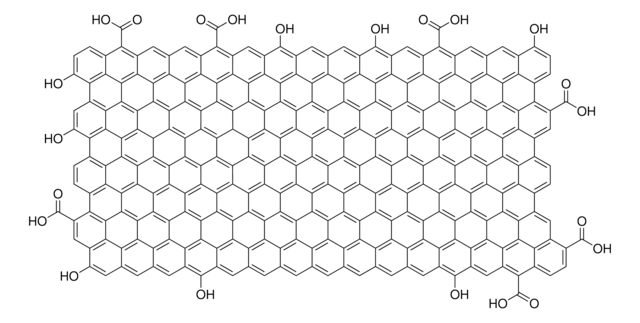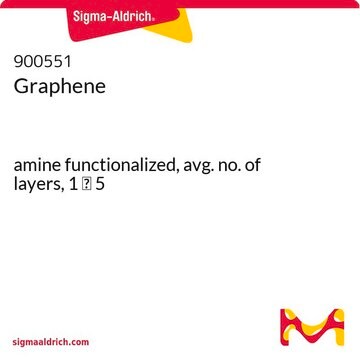This product is not tested for interlayer distance during the quality control process.
796034
Graphene oxide
powder, 15-20 sheets, 4-10% edge-oxidized, avg. no. of layers, 15 ‑ 20
Synonym(s):
graphite oxide
About This Item
Recommended Products
Quality Level
form
powder
feature
avg. no. of layers 15 ‑ 20
solubility
water: dispersible (polar solvents)
bulk density
~1.8 g/cm3
SMILES string
O=C(O)C1C2=C3C4=C5C6=C7C8=C9C%10=C%11C(C%12=C%13C%10=C%14C8=C%15C6=C%16C4=C%17C2=CC(C(O)=O)C%18=C%17C%19=C%16C%20=C%15C%21=C%14C%22=C%13C(C%23=C%24C%22=C%25C%21=C%26C%20=C%27C%19=C%28C%18=CC(C(O)=O)C%29=C%28C%30=C%27C%31=C%26C%32=C%25C%33=C%24C(C%34=C%35C
InChI
1S/C140H42O20/c141-131(142)26-13-23-15-44-62(140(159)160)45-16-24-14-40-31(132(143)144)5-1-29-41-20-48(135(149)150)56-33-7-3-28-27-2-6-32-55-37(133(145)146)11-9-35-60(138(155)156)42-17-25-18-43-61(139(157)158)36-10-12-38(134(147)148)58-46-21-50(137(153)154)59-47-22-49(136(151)152)57-34-8-4-30-39(19-26)51(23)78-72(44)88-75(45)80-52(24)79(54(29)40)95-71(41)83(56)101-93-69(33)64(28)91-90-63(27)68(32)92-86(66(35)55)73(42)81-53(25)82-74(43)87(67(36)58)96-76(46)85(59)103-97-77(47)84(57)102-94-70(34)65(30)89(78)105-104(88)115-98(80)111(95)116(101)126-122-110(93)107(91)120-119-106(90)108(92)99(81)114-100(82)112(96)118(103)128(124(114)119)123-113(97)117(102)127(130(122)129(120)123)121(109(94)105)125(115)126/h2,5,7-10,12-22,26,38,48-50H,1,3-4,6,11H2,(H,141,142)(H,143,144)(H,145,146)(H,147,148)(H,149,150)(H,151,152)(H,153,154)(H,155,156)(H,157,158)(H,159,160)
InChI key
VTWITIAIMADGRM-UHFFFAOYSA-N
Looking for similar products? Visit Product Comparison Guide
Related Categories
General description
- Form: Brown/Black powder
- Bulk Density: ~1.8 g/cm3
- Solubility: Dispersible in water and polar solvents
- Number of layers: 15-20
- Oxidation: 4-10%
Application
- Nanocomposites [1,2]
- Anti-corrosion coatings [3,4]
- Films with barrier properties [5,6]
- Membranes for separation [7,8]
- Conductive inks [9,10]
- Energy storage [11,12]
Storage Class Code
11 - Combustible Solids
WGK
WGK 3
Flash Point(F)
Not applicable
Flash Point(C)
Not applicable
Choose from one of the most recent versions:
Certificates of Analysis (COA)
Don't see the Right Version?
If you require a particular version, you can look up a specific certificate by the Lot or Batch number.
Already Own This Product?
Find documentation for the products that you have recently purchased in the Document Library.
Articles
Since its discovery little more than a decade ago,1 the two-dimensional (2D) allotrope of carbon—graphene—has been the subject of intense multidisciplinary research efforts.
Since its discovery little more than a decade ago,1 the two-dimensional (2D) allotrope of carbon—graphene—has been the subject of intense multidisciplinary research efforts.
Graphene's unique properties spark interdisciplinary interest; its honeycomb structure offers electrical, optical, and mechanical marvels.
Since its discovery little more than a decade ago,1 the two-dimensional (2D) allotrope of carbon—graphene—has been the subject of intense multidisciplinary research efforts.
-
Can I get information about the interlayer distance of this product?
1 answer-
Helpful?
-
-
How can I determine the shelf life / expiration / retest date of this product?
1 answer-
If this product has an expiration or retest date, it will be shown on the Certificate of Analysis (COA, CofA). If there is no retest or expiration date listed on the product's COA, we do not have suitable stability data to determine a shelf life. For these products, the only date on the COA will be the release date; a retest, expiration, or use-by-date will not be displayed.
For all products, we recommend handling per defined conditions as printed in our product literature and website product descriptions. We recommend that products should be routinely inspected by customers to ensure they perform as expected.
For products without retest or expiration dates, our standard warranty of 1 year from the date of shipment is applicable.
For more information, please refer to the Product Dating Information document: https://www.sigmaaldrich.com/deepweb/assets/sigmaaldrich/marketing/global/documents/449/386/product-dating-information-mk.pdfHelpful?
-
-
How is shipping temperature determined? And how is it related to the product storage temperature?
1 answer-
Products may be shipped at a different temperature than the recommended long-term storage temperature. If the product quality is sensitive to short-term exposure to conditions other than the recommended long-term storage, it will be shipped on wet or dry-ice. If the product quality is NOT affected by short-term exposure to conditions other than the recommended long-term storage, it will be shipped at ambient temperature. As shipping routes are configured for minimum transit times, shipping at ambient temperature helps control shipping costs for our customers. For more information, please refer to the Storage and Transport Conditions document: https://www.sigmaaldrich.com/deepweb/assets/sigmaaldrich/marketing/global/documents/316/622/storage-transport-conditions-mk.pdf
Helpful?
-
-
Could you provide TGA results of these GO? I need a high thermal stability GO like 300-400 stable.
1 answer-
Unfortunately, thermogravimetric analysis (TGA) is not performed on this material. The decomposition temperature has not been established. Please see the link below to review an article which suggests that, in general, graphene oxide has a decomposition range by TGA from approximately 125 - 200°C.
https://www.sciencedirect.com/science/article/pii/S2667056923000068#:~:text=Based%20on%20the%20TGA%20and,decomposition%20of%20GO's%20surface%20functionalities.Helpful?
-
-
How can graphene oxide (P/N: 796034) be homogenized in a PBS solution?
1 answer-
The product 796034 is edge functionalized graphene. One method to homogenize it is to use a regular lab ultrasonic bath. The appropriate sonication time depends on the machine power, typically around 15-20 minutes for a 100 Watts ultrasonic bath. If the dispersion is not as expected, the sonication process can be repeated.
Another alternative is to use a homogenizer/cell crasher. A homogenizer with 400-600 Watts is recommended, and it's suggested to set the homogenizer to sonicate for 3 seconds and then pause for 1.5 or 2 seconds, with a total sonication time of 15-20 minutes. Similarly, if the powder is not fully dissolved, the experiment may be repeated.
Helpful?
-
-
What is the particle size of this product (796034, Graphene oxide)? Is it a nanoparticle?
1 answer-
While particle size is not an assigned specification for this product, an estimate is provided below:
d90 - 14.6 μm
d50 - 4.2 μm
d10 - 1.2 μmHelpful?
-
-
May I get the step-by-step procedure including the materials used to synthesize this product graphene oxide (796034)?
1 answer-
This is an MQ100 quality level product, this information is considered proprietary. All of the shareable documentation is on the product page or the documentation linked to on the product page. Synthetic and preparative details are proprietary.
Helpful?
-
-
Dear Sir/Madam, I am loohking for the thermophysical properties of Graphene Oxided product number 796034. Brand : Aldrich regards Adel
1 answer-
Unfortunately the thermophysical properties have not been tested for this product.
Helpful?
-
-
Do you have data on the diffuse reflectance spectra of eo-GO (796034)?
1 answer-
Unfortunately, reflectance spectra is not provided with this product.
Helpful?
-
Active Filters
Our team of scientists has experience in all areas of research including Life Science, Material Science, Chemical Synthesis, Chromatography, Analytical and many others.
Contact Technical Service







